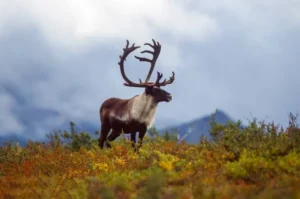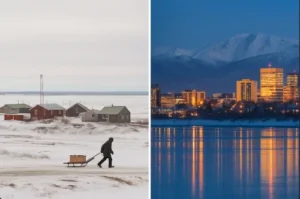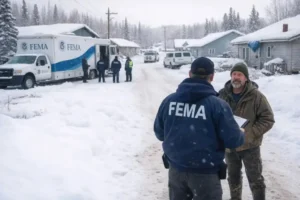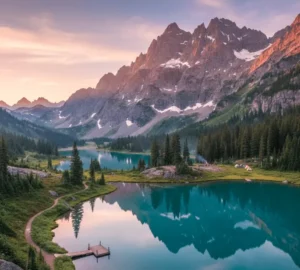Alaska is not dark for six months of the year, but the darkest period occurs from late November through late January, depending on where you are in the state.
Only communities north of the Arctic Circle, such as Utqiagvik (Barrow), experience a period where the sun does not rise at all, lasting from mid-November to late January, according to the Earth Observatory at NASA.
Everywhere else in Alaska still gets daily sunlight, but daylight hours become extremely short from November through January.
Let’s explain exactly which months are the darkest, how daylight changes by region, and why certain parts of Alaska experience extended darkness.
Quick Facts: Alaska’s Dark Months (2025)
| Region | Darkest Months | Total Darkness? | Notes |
| Anchorage | Late Nov – Early Jan | ❌ No | 5 hours daylight in Dec |
| Fairbanks | Late Nov – Early Jan | ❌ No | 3–4 hours daylight in Dec |
| Utqiagvik (Barrow) | Mid-Nov – Late Jan | ✔ Yes | ~65 days of no sunrise |
| Nome | Nov – Jan | ❌ No | Short days, no polar night |
| Kotzebue | Late Nov – Jan | ❌ Minimal | Twilight most of the day |
| Arctic Slope | Nov – Jan | ✔ Partial/Full | Above the Arctic Circle |
Why Alaska Has Dark Months in Winter
Alaska’s dark season happens because of the Earth’s tilt. During winter, northern Alaska tilts away from the sun, resulting in:
- rapid daylight loss
- long nights
- a low sun angle
- and, in the far north, polar night
The farther north you go, the more extreme the darkness becomes.
Which Months Are Dark in Alaska? (Simple Answer)
Here is the statewide overview:
✔ November
Daylight drops sharply everywhere; some Arctic regions begin the polar night.
✔ December
The darkest month of the year for all of Alaska.
✔ January
Darkness continues into late January in Arctic regions; interior cities slowly gain light.
So the core “dark months” in Alaska are:
👉 November, December, and January (varying by region)
Where in Alaska Is It Dark for Months at a Time?
Most people are familiar with the idea of extended darkness because of movies and stories, but the real 30 Days of Night in Alaska happens only in far northern communities like Utqiagvik.
Utqiagvik (Barrow)
- Dark period: ~November 18 to ~January 23
- The sun does not rise for ~65 days
- Twilight provides some light but no actual sunrise
Other Arctic communities
- Wainwright
- Point Hope
- Kaktovik
- Deadhorse / Prudhoe Bay
These locations experience 1–2 months of sun absence, not six.
Are Anchorage or Fairbanks Dark for Months?
No.
Both cities get a daily sunrise year-round, but winter daylight becomes very short.
Anchorage: What Months Are the Darkest?
Anchorage does not experience polar night.
However, daylight becomes minimal from:
- Late November
- December (shortest days)
- Early January
Anchorage daylight during the dark months:
- Early December: ~5.5 hours of daylight
- Late December: ~5 hours
- Early January: ~5.5–6 hours
Anchorage winter is defined by short days, not full darkness.
Fairbanks: What Months Are the Darkest?
Fairbanks doesn’t experience total darkness, but December brings extremely short days and long twilight periods. You can also explore what to do in Fairbanks during winter to make the most of the season.
Most affected months:
- December
- Late November
- Early January
Fairbanks daylight levels:
- December solstice: ~3.5–4 hours of daylight
- Long twilight periods extend usable light
- Still receives a daily sunrise
Fairbanks does not enter total darkness.
Also Read: Winter Wellness in Alaska: How You Can Stay Healthy in the Cold Months?
Month-by-Month Darkness and Daylight Across Alaska (2025 Overview)
| Month | Anchorage | Fairbanks | Utqiagvik (Arctic Alaska) |
| November | 7–8 hours mid-month | 6–7 hours | Sun sets mid-month (darkness begins) |
| December | ~5 hours | ~3.5 hours | No sunrise (full polar night) |
| January | 5–7 hours | 4–6 hours | Sun returns late January |
| February | 8–9 hours | 8 hours | Rapid daylight increase |
| March | 11–12 hours | 11 hours | 9–10 hours |
This table clearly shows that November–January are the true dark months in Alaska, with the Arctic experiencing the most extreme conditions.
Does Alaska Really Have 3 or 6 Months of Darkness?

“Alaska dark for 6 months” → FALSE
This is a myth. No place in Alaska is dark for six months.
“Alaska 3 months of darkness” → PARTLY TRUE
Only Utqiagvik experiences ~2+ months of sun absence.
Other Arctic towns may have 1–2 months of extreme darkness.
What Alaska’s Dark Months Look Like in Real Life
During the darkest time of year:
- The sun rises late and sets early
- Twilight lasts long, creating dim light
- The sun stays low on the horizon
- Days feel shorter due to cloud cover and the weather
- Travel and outdoor activities rely heavily on lighting
Most Alaskans are active year-round despite the darkness.
Also Read: What Happens During Heyi Days in Anchorage 2025? Alaska’s Winter Festival Explained
Summary — What Months of the Year Are It Dark in Alaska?
✔ The darkest months in Alaska are November, December, and January.
✔ Only Arctic Alaska has weeks with no sunrise (mid-November to late January).
✔ Cities like Anchorage and Fairbanks still get daily sunlight, but December has extremely short days.
This variation depends entirely on how far north you are in the state.
FAQs
1. What month is the darkest in Alaska?
December is the darkest month statewide.
2. When does Alaska get no sunlight?
Only Arctic regions experience no sunrise from mid-November to late January.
3. Is Anchorage dark for months?
No. Anchorage always gets daily sunlight, even in December.
4. Is Fairbanks dark for 3 months?
No. Fairbanks has short days but not total darkness.
5. Why does Alaska lose daylight so fast?
Because of Earth’s tilt, there are rapid sunlight changes at northern latitudes.












